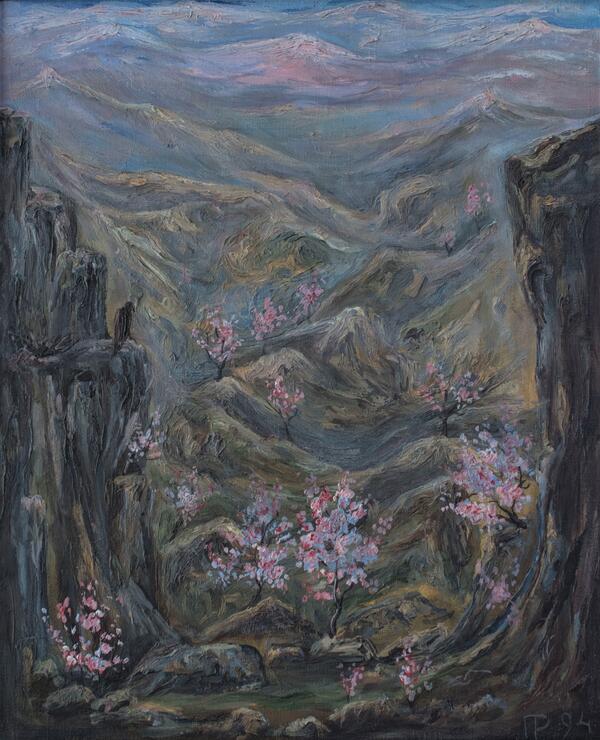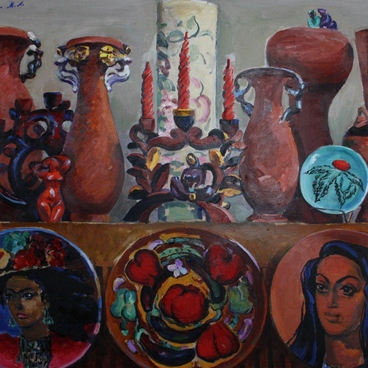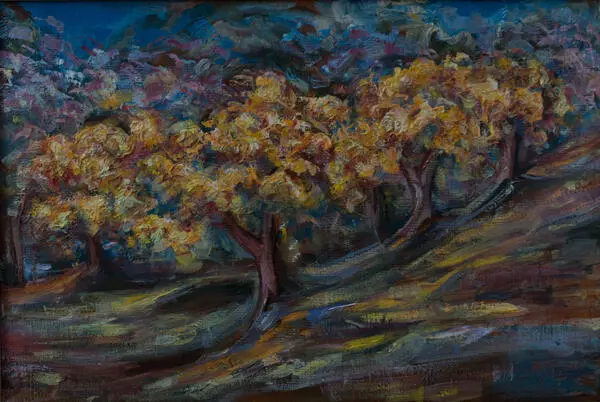In the painting “Almonds Bloom”, naïve artist Robert Papikyan develops the main theme of his work — the paradisiacal life of nature and the plants and animals that live in it. The artist seeks to show the viewer the beauty and tenderness of the world that surrounds us, but at the same time remains unreachable.
In the foreground, on the right and left sides, one can see dark steep cliffs and between them a mountain valley with hills and small blooming almond trees, and in the third plane — a mountain range and a snow-capped peak.
The color palette of the landscape is made up of various shades of gray with blue. The almond trees are clearly visible in the distance, which conveys a sense of clean, fresh mountain air.
The painting depicts almond trees — the most common species in the subgenus Amygdalus (Almond). “Amygdalus” means “beautiful tree” in Greek. Blooming almond trees look very spectacular, as during this period the branches are densely studded with large flowers of white, pink, red and purple with a thick and pleasant smell.
The almond is a shrub or a small tree with gray twigs and smooth bark. It is very branchy and can grow up to 4 or 6 meters. It has pointed dark green leaves.
Most often wild almond trees can be found in Crimea, in the southern territories of the former Soviet Union, in Asia, in the Caucasus, the Tian Shan and the Himalayas. In Israel, it grows in the Haifa area on the very shores of the Mediterranean. Almonds thrive in rubbly, rocky mountain slopes and can grow at an altitude of up to 1.600 meters above sea level.
It is a very light-loving plant, sensitive to frost, especially in spring, but drought-resistant due to its well-developed root system. At 8–10 degrees Celsius almond buds begin to blossom, and at 15 degrees the tree blooms for 10–15 days. Its flowers blossom before the leaves.
Robert Papikyan was born in 1937. In 1966, he graduated from the Faculty of Journalism of Lomonosov Moscow State University. He worked for newspapers, magazines and publishing houses. At the age of 50, Papikyan took up painting and began to study art independently. He rapidly moved through a Realist period. Then he tried his hand at various techniques of folk art stylization. Nowadays, Robert Papikyan works in the naïve art genre. His works are housed in museums in Russia, France and in private collections in Russia and abroad.
In the foreground, on the right and left sides, one can see dark steep cliffs and between them a mountain valley with hills and small blooming almond trees, and in the third plane — a mountain range and a snow-capped peak.
The color palette of the landscape is made up of various shades of gray with blue. The almond trees are clearly visible in the distance, which conveys a sense of clean, fresh mountain air.
The painting depicts almond trees — the most common species in the subgenus Amygdalus (Almond). “Amygdalus” means “beautiful tree” in Greek. Blooming almond trees look very spectacular, as during this period the branches are densely studded with large flowers of white, pink, red and purple with a thick and pleasant smell.
The almond is a shrub or a small tree with gray twigs and smooth bark. It is very branchy and can grow up to 4 or 6 meters. It has pointed dark green leaves.
Most often wild almond trees can be found in Crimea, in the southern territories of the former Soviet Union, in Asia, in the Caucasus, the Tian Shan and the Himalayas. In Israel, it grows in the Haifa area on the very shores of the Mediterranean. Almonds thrive in rubbly, rocky mountain slopes and can grow at an altitude of up to 1.600 meters above sea level.
It is a very light-loving plant, sensitive to frost, especially in spring, but drought-resistant due to its well-developed root system. At 8–10 degrees Celsius almond buds begin to blossom, and at 15 degrees the tree blooms for 10–15 days. Its flowers blossom before the leaves.
Robert Papikyan was born in 1937. In 1966, he graduated from the Faculty of Journalism of Lomonosov Moscow State University. He worked for newspapers, magazines and publishing houses. At the age of 50, Papikyan took up painting and began to study art independently. He rapidly moved through a Realist period. Then he tried his hand at various techniques of folk art stylization. Nowadays, Robert Papikyan works in the naïve art genre. His works are housed in museums in Russia, France and in private collections in Russia and abroad.




